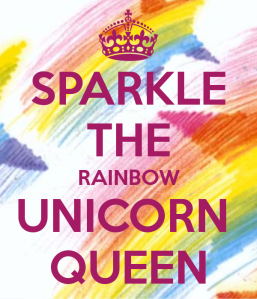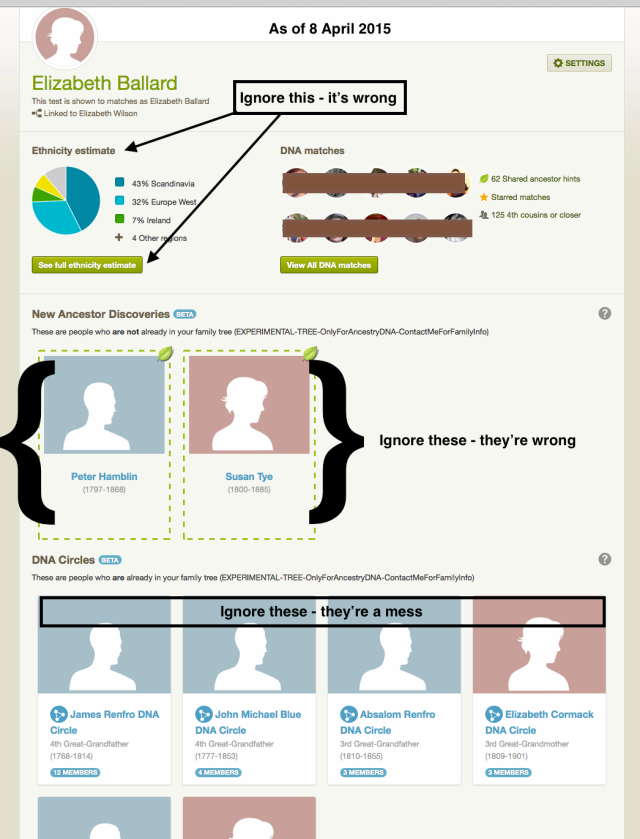 So now that many of us have had our say about AncestryDNA’s failed “New Ancestor Discovery” feature, let’s take a look at what we can do with AncestryDNA. (But PLEASE, continue to have your say about the “New Ancestor Discovery” feature!)
So now that many of us have had our say about AncestryDNA’s failed “New Ancestor Discovery” feature, let’s take a look at what we can do with AncestryDNA. (But PLEASE, continue to have your say about the “New Ancestor Discovery” feature!)
First, I’ll remind you of what Ancestry claims this new feature does (in case anybody questions whether or not it is a failed feature).
The email I received from AncestryDNA, which I showed in Friday’s article, AncestryDNA Has Now Thoroughly Lost Its Mind, is shown again here below.
It says the following:
1) “Now, your DNA can tell you something that was never before possible. AncestryDNA has a new feature that allows you to discover new ancestors—just through your DNA.”
True or false? FALSE
2) “Look for your new ancestor on your DNA results page.”
True or false? FALSE
For more detail, make sure to read Friday’s article, as well as Roberta Estes’ Ancestry Gave Me A New DNA Ancestor – And It’s Wrong and The Legal Genealogist’s (Judy G. Russell) Still waiting for the Holy Grail.
DNA Circles are messed up for a lot of people, too. They are not perfect, but at least they do not claim to show you a new ancestor just through your DNA.
Moving on…
I’m not the expert. I am not even an expert. I’m just a person who, in the past year and a half, has gone from being a genealogist to a genealogist who uses DNA in her research. Thus, I am now a genetic genealogist. Really, though, I’m just a person with a lot of questions who has crammed a lot of knowledge and experience about DNA into my brain within a very short time span.
I had been using Family Tree DNA’s Family Finder and GEDmatch for quite some time before I sent samples to 23andMe and AncestryDNA.
I decided to send my sample to AncestryDNA because some time last year, I read Blaine Bettinger’s The AncestryDNA Witch Hunt. I think AncestryDNA deserves a witch hunt, especially given this latest stunt (yes, I call it a stunt). But I figured I’d give it a try even though I had few expectations. There could always just be that one person who tested at Ancestry and no place else. That one person….
My results came back, and there were a few matches that right away caught my eye. I have had breakthroughs as a result. I have also had breakthroughs from Family Tree DNA, 23andMe, and GEDmatch, so that is not unique.
Please do not be discouraged about genetic genealogy and genealogy in general because of AncestryDNA’s failings. While it is true that AncestryDNA has misled us as well as not listened to us, it a) is not the only game in town and b) should not be the standard we use to judge the validity of the use of DNA in our research.
I have found a way to use AncestryDNA as well as possible, at least in my opinion. This is one way and currently my way. It may not be the best way, and I’m sure it will be honed as time goes on. Feel free to snag it and hone it, or leave your way in the comments. And remember, I am not an expert. I’m just a person.
- Roberta Estes found a way to make AncestryDNA’s sparkly-magical-hidden-matching-shaking-leaf-algorithm take more notice of her tree by putting suspected-but-not-proven-ancestors in it. In other words, give AncestryDNA a sparkly-magical-tree on which to use its sparkly-magical-hidden-matching-shaking-leaf-algorithm, and it’s like Unicorns and Rainbows! Read her article and take special note of what to do and what not to do, and then do it: Getting the Most Out of AncestryDNA. As time goes on, you can make more use of your sparkly tree and your sparkly matches.
- Attach your DNA self to yourself in that tree.
- Make the tree Public.
- Ignore the things that I have marked in this image.

- Download and install Google Chrome browser.
- Keep Calm and Do what it says to do in this article by ItsTime.com – How to use [Jeff Snavely’s] AncestryDNA Helper extension for the Chrome browser. Make sure you read the PDF instructions. Don’t be scared. 🙂 It will take a while, depending on your Internet speed, the speed of your computer, and the number of matches you have. You have not wasted your money on AncestryDNA (although, it may feel like it). Trust me. We’ll get to the good stuff soon.
- You will end up with a spreadsheet of all of your matches (blessed be!). Because AncestryDNA will not let us have chromosomes and segments and cMs and SNPs, you won’t get those. But you will get usernames and contact user IDs and notes and links to the contact forms and a few other things. It is very handy.
- Read this article, too, from ThroughTheTreesBlog, and do what it, or most of it, says: Using AncestryDNA: Steps for Success. The images are a little outdated, so if you get confused, make sure to refer back to the PDF in number 6, above.
- Now you can get to the good stuff. You can start contacting people to ask if they will upload their data to GEDmatch. I suggest that you NOT lead with that question! Here is an example of a successful introductory letter that I have used on AncestryDNA. Just remove or replace the wording that does not apply:
Hello,My name is Elizabeth Ballard, and AncestryDNA shows that we are a DNA match and a tree match. I am not able to see the tree match because your tree is private. I wonder if you and I could work together and figure out how we may be related? The easiest way if you don’t want to make a public tree for AncestryDNA, or if you do not wish to share your tree with me would be if you wish to look at the tree I made public for AncestryDNA. You should be able to see only my pedigree and find a possible common ancestor. The public tree has a caveat that it is experimental and has some things in it that are only common among other trees, but that do not have accessible sources. I have done that in order to have an idea where to start when I match someone.
I hope to hear from you.
Sincerely,
Elizabeth BallardThe point is that you want a kind and gracious introduction, not a “Hello, could you download your junk to GEDmatch so I can see your DNA?” I have found that being kind and gracious can help later. You never know when that person will decide to contact you after he or she has learned more about family or DNA.
- A follow-up email (after you have established communication) could be something like this:
Hello!
I agree! I belong to the NBFA as well. Would you be willing to upload your DNA results into GEDmatch? GEDmatch is run by donation.We could get more detailed genome information that way. I am trying to put together the pieces of which chromosomes and chromosome locations go to which surnames. Strange, but true.Elizabeth
- If the person does upload his or her data to GEDmatch, you can start comparing chromosomes and segments. If the person does not, remember that he or she is not obligated to do so.
I have been successful with these types of exchanges. You can see that the second email sample was one after a series where we were already communicating about where we may be related. I have also had people who aren’t interested. Sometimes people get discouraged, and by the time I am communicating with them, they are turned off to genetic genealogy. That is the most frustrating, because I know it doesn’t have to be that way.
And that is what will continue to happen with the marketing hype and false claims that AncestryDNA is putting out. We who understand what is going on can refer those people to articles, or can explain in our own words how to make the most out of our DNA results. We can use examples of our successes to help steer our wanderers back home.
AncestryDNA can be used, and you can stay sane doing it. Just avoid the crazy parts and you’ll be fine.



I know what you mean…..
LikeLike
Pingback: AncestryDNA is at it Again – Missing Shared Matches | Diggin' Up Graves
Pingback: Diggin’ Up Graves – Favorite Posts of 2014 and 2015 | Diggin' Up Graves
Thank you for the information. I an a bit surprised right from the get go, I got the “Hallelujah” Your DNA Scan Results are IN!!” When i click on it it sends me to a page to get a DNA kit…um, I’ve already done that…remember the email you just sent me? I waited to join Ancestry until the results are back so I could take advantage of the free two week membership, I live on a modest pension and can’t spend money on duplicate services and such.
I am a bit dis-heartened to see the amount of reading I must do to actually get specific info, after 25 years of software nonsense and junk I’m burned out on digging around for things that should right at the top of a piece of software…I’m not a luddite i’m just tired of the junk that passes for software. Anyway thanks for the excellent instructions, hopefully somedays I’ll actually get to them.
LikeLike
You’re welcome, Robert. They even may be outdated, as that was 3 years ago — to the date — that I wrote them. Most likely, you weren’t logged in to your Ancestry account when you clicked in the email. If you log in, go to the and click on DNA, you can get to various options there. AncestryDNA has more features than it did 3 years ago when I wrote this article, but it still doesn’t, and perhaps won’t, provide some basic functionality, such as being able to download a comma-delimited file of your match list. How difficult can that be? I’m aware, too, that so much of what they could provide would be easy to provide.
LikeLike